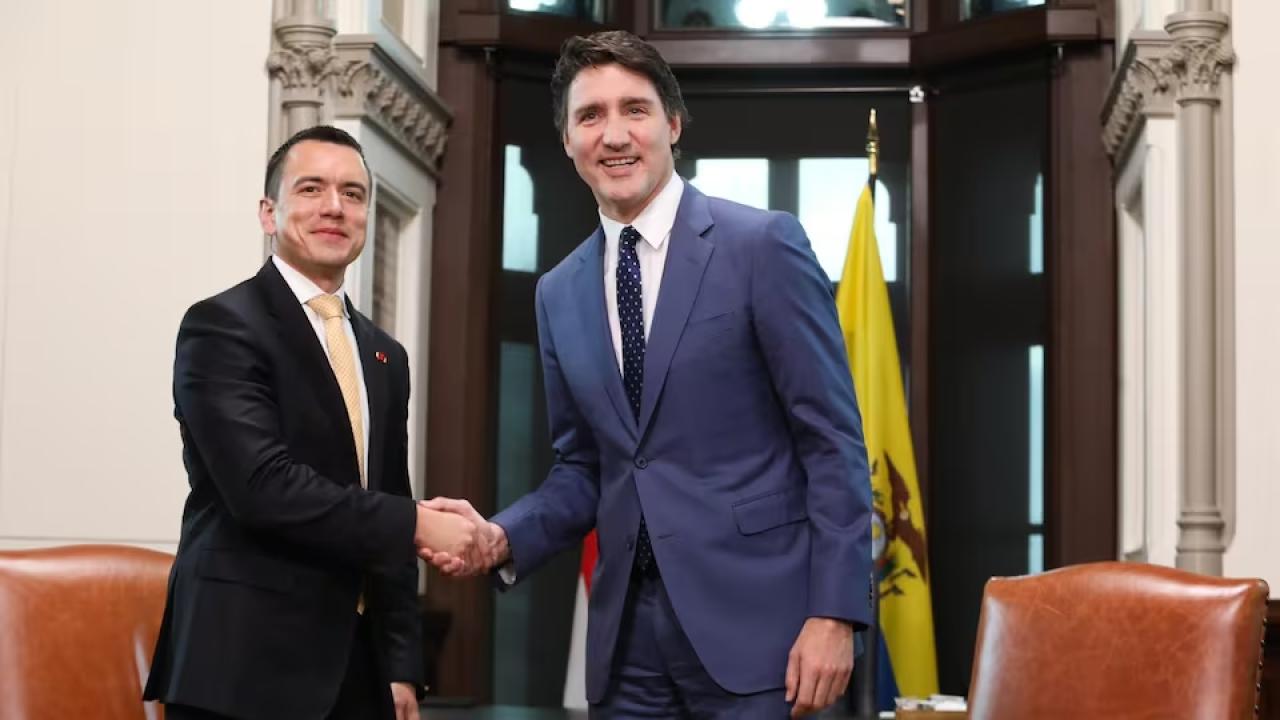
Businessmen and former ministers highlight the benefits of the trade agreement between Ecuador and Canada.
The trade agreement between Ecuador and Canada generates great expectations for the different productive sectors of the Andean country.
This is due to the opportunity to position the non-traditional exportable offer in a market of nearly 40 million inhabitants, as well as for the generation of investment in key areas such as mining, and even "will allow for equalizing tariff conditions with Colombia, Peru and Chile", which have had agreements with Canada for more than fifteen years.
The details of the final text of the agreement are not yet known, as negotiations only concluded on January 31. Six rounds were held, beginning on April 29, 2024. The pre-negotiation phase began in 2022.
“Ecuador will have a trade agreement with Canada,” announced President Daniel Noboa on February 2, when he announced that negotiations had concluded.
And through a statement, the Presidency of the Republic indicated the beneficiaries of this commercial instrument for key sectors such as floriculture, food, tuna, textiles, auto parts, ceramics, footwear, wood, juices and pulps, cosmetics, plastics, hats, tagua, among others, in which the generation of employment and the development of micro, small and medium-sized enterprises will be promoted.
For the former Ministers of Production, Foreign Trade, Investments and Fisheries Daniel Legarda and Julio José Prado, the announcement of the end of the negotiations of the agreement is “good news”. They consider that it is evident that the trade agenda is already a State policy.
Legarda participated in the negotiations from the private sector as director of the Negotiations Committee of the Free Trade Agreement of the Ecuadorian-Canadian Chamber of Guayaquil.
He points out that this "allows us to see that the policy of trade agreements is a State policy... It is an issue that transcends governments, presidents and that reflects the interests of the productive sector."
Prado says that there is still “a long way to go” before the agreement comes into force, because after the end of negotiations there is a stage of text review to ensure that everything that has been negotiated and agreed upon is in writing. After that comes the signing process and then ratification in the National Assembly.
“There is still a process to be completed, but it is good that it has already been achieved in a timely manner... It also shows that Ecuador's trade agenda is already a state policy... there are few issues that are given continuity throughout governments,” says the director of the economic environment area of the IDE Business School.
EQUALIZATION OF TARIFFS WITH NEIGHBORING COUNTRIES
The executive president of the Ecuadorian Federation of Exporters (Fedexpor), Felipe Ribadeneira, indicates that the deepening of the commercial relationship with Canada represents an opportunity to position the non-traditional exportable offer in a market of nearly 40 million inhabitants with a purchasing power that is about nine times that of a national consumer.
Ribadeneira comments that this agreement will allow for equalizing tariff conditions with Colombia, Peru and Chile, which have had trade agreements with Canada for more than fifteen years, and in this way will provide “greater room to compete, especially in products such as roses and other flowers, as well as in the export of canned tuna and canned fruit, which face tariffs in that market.”
Along the same lines, the Guayaquil Chamber of Industries (CIG) points out that Ecuador currently depends largely on exports to the United States, the European Union and China.
“An agreement with Canada would reduce this dependency and strengthen Ecuador’s presence in North America,” he says.
He added that it will bring benefits to the country, boosting trade, investment and productive diversification, and that Canada is a market with high purchasing power and economic stability, which makes it a strategic partner for Ecuador.
The president of the Guayaquil Chamber of Commerce (CCG), Miguel Ángel González, adds that the agreement with Canada opens a market twice as large as ours, positioning it as a strategic commercial partner, both in mining products and in agricultural and aquaculture products.
It indicates that mining exports to Canada have grown strongly and, according to data from November 2024, reached US$86.5 million.
He also mentioned some figures for the highlighted products: cocoa (US$ 70 million), shrimp (US$ 34 million) and flowers (US$ 33.8 million), but that cocoa was a star product due to an 84% growth compared to 2023.
In the bilateral relationship, current trade with Canada is US$ 1.1 billion and could increase, especially exports which total around US$ 470 million, according to Legarda, initially by approximately US$ 170 million in the medium and short term.
“This could be greater with new export products that are incorporated. For Ecuador, the negotiation is highly favorable, because it will allow practically 100% of the exports that are made today to enter with zero tariff from the first day of the agreement's validity,” he says.
OPPORTUNITY FOR MINING AND OTHER SECTORS
The CIG adds that the agreement would encourage Canadian investment in key sectors such as mining, renewable energy and infrastructure. “Canada is one of the main investors in mining in Ecuador, and a stable trade framework could attract more capital for responsible and sustainable projects,” it notes.
The CCG president also maintains that there is a lot of potential for growth in Canada in several sectors, such as the banana sector (US$ 87 million) and the shrimp sector (US$ 18 million).
The CIG has a similar opinion, stating that the main benefits of the agreement “would be preferential access to a market that demands agricultural and agro-industrial products, sectors where Ecuador has competitive advantages, so products such as bananas, cocoa, flowers, coffee and seafood could enter with lower tariffs, improving the competitiveness of Ecuadorian exporters.”
The executive director of the Chamber of Industries, Production and Employment of Cuenca, Sofía Arce, also comments that the agreement particularly benefits the flower sector, because Ecuador is the second largest producer of roses after Colombia.
In addition to offering opportunities for exporters of cocoa, tuna, and shrimp, Arce indicates that in the case of products manufactured in Cuenca and Azuay, they see potential for white goods, alcoholic and non-alcoholic beverages, ceramics, and cosmetics.
"We consider the recognition of professional qualifications to be extremely valuable, as well as the chapters referring to productive chains and the promotion of investments," he emphasizes.
According to Fedexpor, the main export products facing tariffs in Canada are roses at 10.5%; between 4.5% and 7% for canned tuna and between 4% and 6% for canned fruit.
Legarda says that bananas and shrimp did not pay tariffs, since Canada already had a reduced tariff of 0% and “with this agreement, that zero is already consolidated, it will no longer be able to increase.” He adds that Ecuador currently exports approximately 130 products.
Regarding imports from Canada, he says that almost 50% of the imports are wheat and soybeans and have a 0% tariff and that will also be consolidated for them with the agreement, but what had a tariff to enter Ecuador and will no longer have are medicines, capital goods such as helicopters, as well as plastic products, polymers, etc.
Legarda, who is also CEO of Exportconsulting, indicates that once the agreement is in force, for Ecuador almost 100% of what it exports will have a 0% tariff immediately, although there are other products that will be subject to it in a shorter period of time. Meanwhile, for Canada, a little more than 90% will be immediately and other products will be subject to it progressively, up to ten years.









